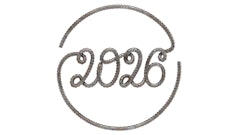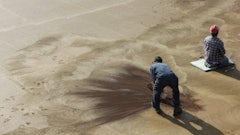The decorative concrete industry is booming and lots of folks are asking, why?
One reason is that there has been tremendous advancement in the number and types of decorative concrete products, supplies and tools – microtoppings, overlays, stamps, colors, acid stains, dyes, water-based stains, epoxy terrazzo, form liners, cutting tools, etc.
These products, supplies and tools have accelerated the creativity of those in the concrete business and have drawn in creative types from outside the industry who now like to use concrete as their canvas – and are helping to take it to a new level.
Here is information about two techniques that are making headlines in the concrete industry.
Elastomeric urethane form liners
The desert wall that runs along the Pima Freeway, called “The Path Most Traveled,” ranges in height from 20 to 60 ft. and is adorned with nearly 100 abstract and representational desert-inspired motifs, including prickly pear cacti 40 ft. tall and giant lizards 67 ft. long. The images are actually molded into concrete, providing a permanent display to be enjoyed by travelers for decades to come.
Architectural concrete walls, with original artwork or other graphics cast in relief in the surface, are gaining in popularity for a variety of public and commercial projects, including retaining walls, bridges, privacy walls and sound barriers.
Such large-scale, bas-relief images in concrete are possible with the use of custom form liners molded from original art. All the liners for the Pima Freeway project were provided by Scott System, a Denver inventor and manufacturer of reuseable elastomeric urethane form liners.
In addition to providing all the liners for this project, Scott System has worked with other community groups, architects and transportation departments across the country to turn imposing concrete walls into aesthetically pleasing art.
Transforming plain concrete walls into original art is often a collaborative effort. The process begins with the design team agreeing on a vision for the project, and then artists are commissioned to create conceptual drawings. Once the design is approved, the artist produces a 3-D prototype (usually of modeling clay or polystyrene foam) from which a casting is made to produce a liner in the reverse image of the original work. The liners are attached to the inside of the wall forms into which the wet concrete is placed. When the forms are removed after the concrete sets, the transferred design is revealed. At this point, acrylic stains can be applied to provide accents of color. Or the concrete can be integrally colored before it’s placed into the forms.
The elastomeric urethane used to produce the liners is highly durable and moldable. Size is also no limitation. The urethane is flexible, so huge liners can be produced without any seams. Most highway projects today are using mechanically stabilized earth (MSE) walls that consist of 5- by 5-ft. concrete sections.
Scott System also produces form liners that replicate the textures of natural stone and wood. These liners are cast off the actual materials, resulting in a high degree of realism. Other liner patterns offered include brick and block, fractured fins and flutes.
Epoxy terrazzo toppings
Invented by the Venetians in the 1500s, cement-based terrazzo is one of the oldest types of decorative flooring systems. This mosaic-like floor topping – made by embedding small pieces of marble or granite in mortar, followed by polishing – is still highly prized for its timeless beauty. But a newer type of terrazzo has entered the scene, offering a host of benefits that threaten to shrink the market for traditional cement-based systems.
This formidable competitor is thin-set epoxy terrazzo – a poured-in-place topping for concrete substrates that goes on at a thickness of only 1/4 to 3/8 in., as opposed to traditional terrazzo that must be applied at thicknesses of 2 to 3 in. This modern-day terrazzo is excellent for multicolored patterns and designs because the epoxy resin matrix can be pigmented, like paint, to achieve an unlimited spectrum of colors. And it can accommodate a wider variety of richly colored aggregates, including chips of marble or granite, recycled glass, mother of pearl and various synthetic materials. With the creative use of divider strips to separate areas of contrasting colors, it’s possible to produce borders, logos, geometric designs and other artistic compositions.
But the aesthetic value of epoxy terrazzo isn’t the only reason these toppings are gaining in popularity, and why they have captured more than 70 percent of today’s terrazzo market. They also offer outstanding durability and wear, making them tough enough for use in high-traffic commercial and industrial environments. Because the binder is 100 percent epoxy, the finished floor surface provides greater resiliency, chemical resistance, compressive strengths and flexibility than cement-based systems.
Jim Peterson is founder and president of ConcreteNetwork.com (www.concretenetwork.com), a website serving more than 400,000 visitors per month. He is also a principal in High Grade Form, Inc., a foundation contractor located in Perris, Calif.















